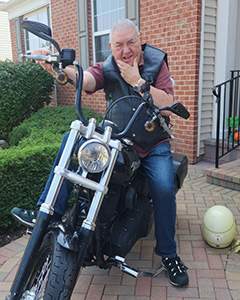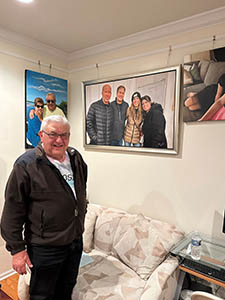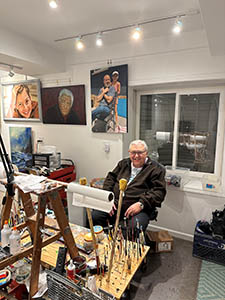Army Vietnam War Flight date: 08/28/24
By Mark Campana, Honor Flight Chicago Veteran Interview Volunteer
Jerry Zabel was born in 1947 just outside of Munich, Germany. His mother and father, who met shortly after World War II while working at a clothing factory, were both survivors of the Holocaust; having endured life in concentration camps at the forefront. Jerry’s mother lost her first husband, a daughter, and more than 60 family members to the Nazi Party while his father lost more than 120 family members. However, after overcoming the ultimate set of barriers, they maintained hope together and started a family.
The Zabel family of three immigrated to the United States when Jerry was just 2 ½ years old. An uncle took the family in and supported them as they began their life in Illinois. After settling into the southwestern Chicago suburb of Lawndale, they soon realized that no one spoke English near their new home. Over time, the Zabel family not only learned to speak English through their work in local factories around Chicago, but also of the increasingly rough nature of their neighborhood. Given this reality, Jerry’s parents moved them to Albany Park as he entered grade school; and it was at this new school that Jerry met the future love of his life.
After graduating high school, Jerry enrolled for full-time classes at the University of Illinois Chicago in pursuit of furthering his education; but he struggled with his class work. Not understanding why college was so difficult for him at the time, he decided it was time for a change of direction.
It was 1965 and the war in Vietnam was raging. Jerry’s thoughts consistently led him back to the Allied Troops and their liberation of the Jewish people from the Nazi concentration camps in WWII, and how the people of Vietnam now seemed to be similarly oppressed. It was that which motivated him to enlist in the U.S. Army.
Upon completion of basic training at Fort Knox in Kentucky, Jerry moved on to Advance Individual Training for the U.S. Army Infantry at Fort Polk in Louisiana. Many may remember Fort Polk by its moniker, “Tigerland,” aptly named for its use of immersive training imagery on base. During Jerry’s time in Louisiana, ranking instructors had returned from Vietnam with knowledge of how drastically different the terrain was in southeast Asia from the terrain their troops were training in stateside. As a way to start mentally assimilating soldiers to the environment they were heading to, these instructors placed bamboo at the fort’s front gates. Drawing inspiration from this, a colonel took the plan a step further and ordered bamboo by the truckload for every building and training space on base. Jerry was part of the team assigned to placing that bamboo, and thus, “Tigerland” was born.




What had seemed to be a typical enlistment and training deployment for Jerry up until this point was about to become anything but typical in the coming days.
Jerry was eventually assigned to the 378th Maintenance Company for drill instructor training. Soon after, and without any reason given, he was unexpectedly re-assigned to become a culinary specialist. While training as a cook, however, Jerry also secretly worked in covert operations. He was in the U.S. Army for 2 ½ years before arriving at Long Binh Post for a tour of duty in Vietnam that would last only four months.
Due to the top-secret nature of his deployment, Jerry hid in plain sight as a cook. He will not share details surrounding his special assignment in Vietnam; it’s covered by the Espionage Act of 1917.
Life for this cook from the 378th had much more to come than he could have ever anticipated. Before leaving Long Bihn, Jerry suffered an encounter with Agent Orange; leaving him drenched in the deadly chemical defoliant. Alongside many other service members who were exposed to the horrific effects of this contaminant, Jerry would later learn just how harmful the effects of their exposure would become. His body has been ravaged by cancer related to the Agent Orange, but it has never affected his spirit.
Upon arriving back in the U.S. in the summer of ‘68, Jerry married the girl he fell in love with in Albany Park as a grade schooler, and together, they started a family. He registered for part-time classes at Roosevelt University and secured a management job at Montgomery Ward. He had officially began writing the next chapter of his life.
While running a Pick Pack Ship department at Ward, Jerry attended classes at night. Part-time school proved to be much easier for him than full-time had been, and it wasn’t until later in life that he would find a possible explanation for that. Jerry’s son was eventually diagnosed with ADHD, which shed valuable light on the questions surrounding Jerry’s history with academics. With this new perspective, he decided to obtain an MBA and after completing an IQ test, Jerry was invited to join Mensa, the high-IQ Society.
By 1974, Jerry only needed two credit hours to secure his bachelor’s degree. To avoid committing to more hours than his degree required, he found a two-credit hour art course in acrylic painting. He enrolled simply to check a box, but much to his surprise, this class would make painting a precious part of his life for the next 50 years.
Jerry went on to an incredible career of managing business for the renowned suit maker Hart Schaffner Marx, which was interestingly following in the footsteps of his parents, who worked at that same factory in Germany years earlier. He eventually moved on to work for Abbott Labs, Jensen Loudspeakers, and wrapped up his management career with Oracle; all the while honing his skills as a painter.
Aside from his accomplishments as a husband, father, and veteran, his abilities as an artist may be his proudest; and what an artist he is. Jerry can paint pictures that have the realism of a photograph while creating the depths of contrast that can only be expressed through a paint brush. His paintings regularly take more than 200 hours to complete, and he is among but a few elite artists who can create art of this caliber.
The VA uses the creative arts as a form of rehabilitation treatment to help veterans cope with PTSD. They host an annual competition, the National Veterans Creative Arts Festival, to discover and showcase the artistic achievements of U.S. veterans from across the country. Among the numerous fine art awards Jerry has received as a painter, he is notably a first-place finisher in the Military Combat Experience category and a second-place finisher in the Oil Painting category. He’s also been asked to assist doctors with some of the most severe cases of PTSD; after they learned that although Jerry could not articulate his PTSD in words, he painted brilliant descriptions of what PTSD could mean for veterans. He helps other veterans express their feelings and experiences through the arts when they may not have the opportunity to do so themselves. His work with those suffering from PTSD is documented in articles and has been rewarded with many accolades.
Before ending my interview with Jerry, I wanted to know what motivated him to enlist in the infantry and specifically, requesting to be deployed to Vietnam. His answer was very simple:
“It was my way of paying back America for saving so many from the Nazis during World War II.”


